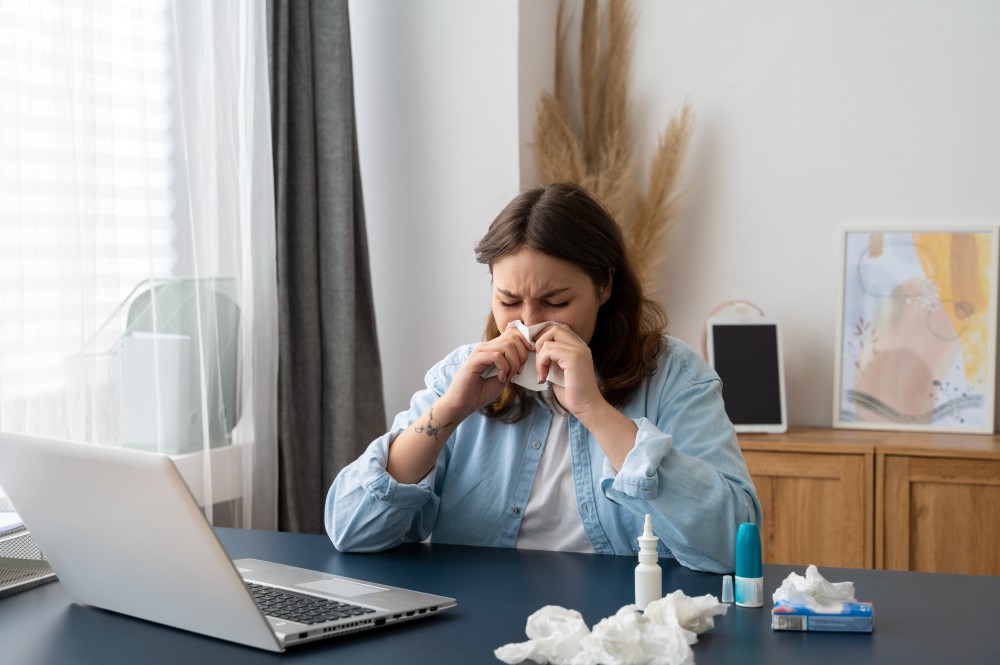
Fine dust in the air, high humidity, along with a rise in the pollen during summer, can contribute to airway irritation, frequent sneezing and coughing especially in susceptible individuals.
Due to high humidity and increased use of air conditioning, it’s not uncommon to see a rise in indoor allergens like mold and dust mites which can further aggravate the problem.
Aggravating factors of a poor environment, either at work or in the home, can create havoc for those already suffering with respiratory problems like asthma or cardiopulmonary obstructive disorder.
Allergic rhinitis is a seasonal disease, and the highest incidence usually occurs during winter and spring. During summer, the incidence of allergic rhinitis is the lowest, and we usually see fewer allergic rhinitis patients in the clinics.
A regional study of asthma in 2018, published in the BMC Pulmonary Medicine journal, found between 4.4 and 7.6 per cent of the Middle East population had the condition. That figure was slightly lower than the numbers reported in Europe and North America, with prevalence of asthma in the UAE estimated to be between 2.79-8 per cent of the population.
Dr Kiran Kumar Rai, head of pediatrics at Burjeel Day Surgery Centre, Reem Island, said regular maintenance of air-conditioning units can help to reduce symptoms of poor air quality inside homes.
The main allergies are caused by air conditioning, particularly in children who are spending more time indoors, he said.
In other parts of the world, it usually happens in spring from pollen and flowering plants. Here it is more likely a result of the indoor environment and also dust and sand in the air outside. It can be a problem when it is windy as fine particles of dust can cause an allergic response,” Dr Rai said. People should try and stay inside at this time, or at least wear a facemask if they need to go out then. If there is fungal mold, particularly in the AC ducts at home or in the office, it will cause a reaction so they should be cleaned regularly.”
It is a part of the reaction of the body to a misdirected defense response from the body. This occurs when the body’s own defense cells called antibodies start attacking substances like pollen, wheat threshing dust, dust, etc. In other words, the body’s defense cells, which are meant to fight micro-organisms like bacteria and viruses, start attacking substances like pollen which are otherwise harmless to our body. This interaction between the defense cells (antibodies) and substances like pollen, wheat threshing dust (antigens), etc. results in the production of a substance, histamine, which is responsible for all local symptoms produced during allergies.
Some symptoms arise immediately after exposure to the allergen and some of the symptoms may develop later. Its pertinent to mention here that symptoms of allergic rhinitis are not life-threatening but can seriously affect the quality of one’s life. The symptoms may occur only in a particular season or all the year around, which depends on the type of allergic rhinitis. Following symptoms arise immediately on exposure to allergen:
The two types include seasonal and perennial allergic rhinitis.
It occurs during a particular time of the year i.e. in spring, summer and early fall. It occurs from response to outdoor allergens like pollen. It occurs during this time because pollen count is high with trees and weeds in full bloom.
Its symptoms can occur throughout the year. It happens from exposure to indoor allergens like dust mites and pet dander. The symptoms may worsen in winter when time spent indoors increases.
The common allergens that can trigger nasal allergy are as follows:
Though allergic rhinitis cannot be prevented but some preventive measures can help reduce the intensity of its symptoms. These are as follows:
According to a research paper published in Asia Pacific allergy journal (The role of Vitamin D in allergic rhinitis), decreased levels of Vitamin D worsens allergic rhinitis symptoms. Vitamin D controls or modulate defense cells (over-activation of which increases allergic rhinitis symptoms), so vitamin D levels are very important to treat allergic rhinitis.
In a similar experiment by the Pediatric Department of University of Lordz in Poland, a trial was done on children. It was seen that in children who received vitamin D 1000 IU daily, there was significant reduction in allergy symptoms.
From the above-mentioned papers, it is clearly evident that vitamin D 1000 IU daily during allergy period can offer significant relief.
In allergic rhinitis, homeopathic medicines work by optimizing the overactive immune system. Homeopathic medicines provide a stimulus (in a highly diluted form) to the body similar to what the trigger or allergen would have produced, leading to the gradual desensitization of the immune system. Homeopathic medicines used for treating allergic rhinitis mainly come from plants or organic substances. So, they do not have any side-effects and help in recovering naturally.
The top five homeopathic medicines to treat allergic rhinitis are Natrum Mur, Sabadilla, Arsenic Album, Sulphur and Arundo Mauritanica. Two medicines that require a special mention in homeopathy are Galphima Glauca and Histaminum. Both of them have been lately introduced in homeopathy and have done wonders in treating the acute symptoms of allergic rhinitis.
The prevalence of asthma, allergic rhinitis, and atopic dermatitis in the UAE is comparable to that in neighboring countries; the prevalence of asthma, wheezing, and hay fever was higher in the 6- to 7-year-old group, while in the 13- to 14-year-old group, the prevalence of allergic rhinitis and atopic dermatitis was higher. Overall, the prevalence of any history of asthma was highest in Ras Al Khaimah, followed by Dubai, and lowest in Ajman. Our findings suggest that allergic disorders represent a healthcare burden in the UAE and more efforts are needed to organize nationwide campaigns to detect undiagnosed children to overcome the burden caused by these conditions.